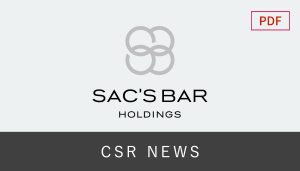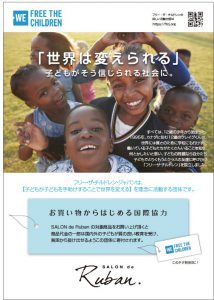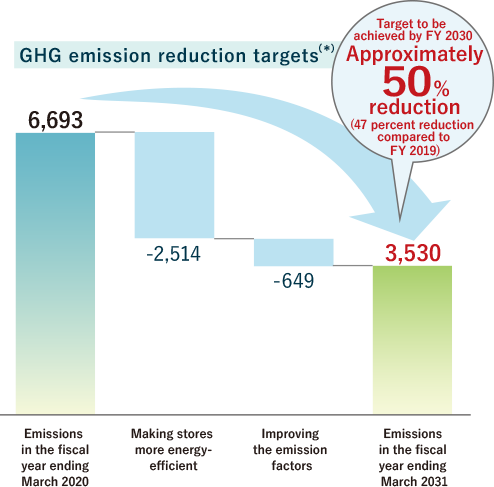We support
Japanese
manufacturing.
What we can do as a member of society.
As a leading company in the fashion goods industry,
Sac’s Bar Holdings recognizes its significant influence on society and the global environment.
We strive to fulfill our social responsibilities through development of the industry,
placing the highest priority on consumer welfare and sustainability in the industry and society.
- SUSTAINABLE
Behavioral Guidelines - CSR NEWS
- Correspondences
to the TCFD Recommendations - Announcement of
‘Multi-Stakeholder Policy’
SUSTAINABLE Behavioral Guidelines
-

-

We promote economic revitalization throughout Japan, as well as in developing countries.
-

We make contributions
to building
a fair society. -

We make
environmental
conservation efforts.
CSR NEWS
_英語ページ用-300x171.jpg) CSRCSR2025.06.01Announcement of ‘Our Policy on Customer Harassment’READ MORE
CSRCSR2025.06.01Announcement of ‘Our Policy on Customer Harassment’READ MORE CSRCSR2025.03.27Announcement of ‘Multi-Stakeholder Policy’READ MORE
CSRCSR2025.03.27Announcement of ‘Multi-Stakeholder Policy’READ MORE CSRCSR2023.12.22Calculation and reduction targets for Scope 1 and 2 greenhouse gas (GHG) emissionsREAD MORE
CSRCSR2023.12.22Calculation and reduction targets for Scope 1 and 2 greenhouse gas (GHG) emissionsREAD MORE CSRCSR2022.08.29LEZZA BOTANICA is kissora’s new product line for ethical productsREAD MORE
CSRCSR2022.08.29LEZZA BOTANICA is kissora’s new product line for ethical productsREAD MORE CSRCSR2021.10.12Through selling SAORI bags, kissora assists persons with challenges to be independentREAD MORE
CSRCSR2021.10.12Through selling SAORI bags, kissora assists persons with challenges to be independentREAD MORE CSRCSR2021.03.03SALON de RUBAN supports Free The ChildrenREAD MORE
CSRCSR2021.03.03SALON de RUBAN supports Free The ChildrenREAD MORE
CORRESPONDENCES to the TCFD RECOMMENDATIONS
Being aware of the impact of climate change on sustainable growth, we are taking measures based on the TCFD Recommendations. In FY 2022, we examined possible risks and opportunities that climate change may cause in the retail business selling bags and other fashion products. We will continue to examine such risks and opportunities and disclose information appropriately.
* TCFD stands for the Task Force on Climate-related Financial Disclosures.
Requested by the G20 leaders, the Financial Stability Board (FSB) established the task force.
-
 GOVERNANCE
GOVERNANCEThe Administration Manager, who is the chairperson of the Sustainability Committee, was appointed as the person in charge of climate-related issues. At the Sustainability Committee, which is an advisory committee for the director in charge of sustainability issues, members examine climate-related issues at least twice a year. Through the director in charge of sustainability issues, their research results are reported to the Board of Directors at least twice a year.
In order to identify and assess climate-change-related risks and opportunities and examine our responses, we have established the Climate Change Working Group under the Sustainability Committee. The Climate Change Working Group reviews the climate-change-related risks and opportunities annually.
-
 RISK MANAGEMENT
RISK MANAGEMENTThe Climate Change Working Group assesses the significance of each climate-change-related risk and opportunity factor in terms of the probability of occurrence, degree of impact, whether countermeasures exist and other such factors. For the assessment, scenarios developed by the International Energy Agency (IEA), Intergovernmental Panel on Climate Change (IPCC) and other such organizations are consulted and personnel in the relevant sections are interviewed as required. The assessment is revised annually. In addition, we plan countermeasures for the risks and opportunities, and keep a close eye on the progress of such countermeasures as compared to the established indexes.
Based on the assessment made by the Climate Change Working Group, the Sustainability Committee comprehensively manages climate-change-related risks, together with other risks that we face. As for highly significant climate-change-related risks and opportunities, the committee reports them to the Board of Directors through the director in charge of sustainability issues.
IEA:International Energy Agency
IPCC:Intergovernmental Panel on Climate Change
-
 STRATEGY
STRATEGY[ Scenario analysis < SCENARIO ANALYSIS > ]
In the current scenario analysis, we examined the impact that may occur in FY 2030 on the retail business selling bags and other fashion products, which is our main business. We examined two scenarios, i.e., 2-degree-centigrade and 4-degree-centigrade scenarios. In the 2-degree-centigrade scenario, the world economy is more decarbonized. In the 4-degree-centigrade scenario, the global warming is more serious without further efforts to address global warming. In our analysis, we consulted the World Energy Outlook scenarios published by the IEA, the Shared Socio-Economic Pathway (SSP) scenario adopted by the IPCC, the Representative Concentration Pathways (RCP) scenario and other future prospects and plans. For each risk or opportunity factor, we consulted scenarios forecasting larger significance.
After extracting risks and opportunities based on the scenarios and examining countermeasures to be taken, we concluded that no significant business risks caused by climate change exist for the retail business selling bags and other fashion products.
Event Possible impact Countermeasures Transition
risksIntroduction of
environmental regulations on
products made from oilIncreased purchase prices for
shifting toward alternative
materialsReviewing materials to develop
environment-friendly merchandiseChanges in developer
demandsDemands to sell
environment-friendly merchandiseReviewing materials and processes
to develop environment-friendly
merchandisePhysical
risksMore frequent and severe
weather disastersBeing struck by disasters,
suppliers cannot supply
merchandiseIdentifying risks in the supply
chains and developing
countermeasuresChanges in climate patterns,
including average
temperature and rainfallIncrease in purchase price due to
increased cost for leather and
other materialsReviewing materials to develop
environment-friendly merchandiseOpportunities Changes in developer
demandsMore demands for stores selling
environment-friendly merchandiseReviewing materials and processes
to develop environment-friendly
merchandiseChanges in consumer
selection and behaviorNew demands are created for
environment-friendly merchandiseReviewing materials and processes
to develop environment-friendly
merchandise
Calculation and reduction targets for Scope 1 and 2 greenhouse gas (GHG) emissions
【Past GHG emissions】
●Approximately 99 percent of GHG emissions from our group companies are indirect emissions (Scope 2) due to electricity consumption and other such reasons
| Unit: t-CO2 | FY 2019 | FY 2020 | FY 2021 | FY 2022 | FY 2023 | |
|---|---|---|---|---|---|---|
| Scope 1 | GHG emissions from fuel use | 137 | 125 | 128 | 132 | 161 |
| Scope2 | GHG emissions from electricity use | 7,024 | 5,996 | 5,969 | 6,257 | 5,774 |
| GHG emissions from air-conditioning | 2,208 | 2,693 | 3,212 | 3,293 | 3,276 | |
| Subtotal | 9,232 | 8,689 | 9,181 | 9,551 | 9,050 | |
| Total (*1) | 9,370 | 8,814(*2) | 9,309 | 9,683(*3) | 9,211 | |
- *1: Consolidated GHG emissions from our group companies
- *2: In FY 2020, our stores were temporarily closed due to the COVID-19 pandemic, reducing our GHG emissions.
- *3: In FY 2022, our business gradually recovered from the COVID-19 pandemic, increasing our GHG emissions.
●Most of Scope 2 GHG emissions from our group companies are caused by electricity use and air-conditioning for store operations.
| Unit: t-CO2 | FY 2019 | FY 2020 | FY 2021 | FY 2022 | FY 2023 |
|---|---|---|---|---|---|
| Scope 2 GHG emissions | 9,232 | 8,689 | 9,181 | 9,551 | 9,050 |
| GHG emissions from electricity use at our stores | 6,596 | 5,618 | 5,622 | 5,925 | 5,448 |
| GHG emissions from air-conditioning at our stores (*) | 2,208 | 2,693 | 3,212 | 3,293 | 3,276 |
| GHG emissions from other sources | 428 | 378 | 347 | 332 | 326 |
| Number of Tokyo Derica Co., Ltd.' s stores | 626 | 630 | 608 | 569 | 555 |
| Total floor area of Tokyo Derica Co., Ltd.' s stores (m²) | 79,163.46 | 81,453.50 | 80,481.56 | 78,352.75 | 78,086.83 |
- *: Our stores emitted more CO2 from air-conditioning in FY 2023 than FY 2019. Since air-conditioning is controlled by operators of shopping malls and other such commercial facilities and our stores cannot control it directly, we are discussing with commercial facility operators, such as requesting them to supply electricity from renewable energy sources, to reduce CO2 emissions.
【Reduction of GHG emissions】
Through promoting energy-saving measures, such as having more LED lighting at our stores, we aim to reduce GHG emissions from electricity use at our stores by 47 percent by FY 2030 compared to FY 2019.

- GHG emission reduction measure 1:
Saving energy at our stores -
●When opening new stores, we will use only LED lighting to make the stores more energy-efficient.
●We will renovate our existing stores to make them more energy-efficient and reduce GHG emissions.
- GHG emission reduction measure 2:
Discussing with
commercial facility operators -
●Concerning electricity used at shopping malls and other commercial facilities, we are discussing with commercial facility operators, such as requesting them to supply electricity from renewable energy sources. If commercial facility operators agree to supply more electricity from renewable energy sources, we will be able to reduce our GHG emissions more.
- *The above emission reduction targets are those for Tokyo Derica Co., Ltd., which emits the largest Scope 2 emissions among our group companies. (In FY 2019, Tokyo Derica Co., Ltd. emitted approximately 95 percent of the total Scope 2 emissions of our group companies.)



